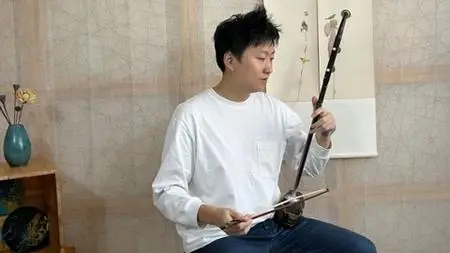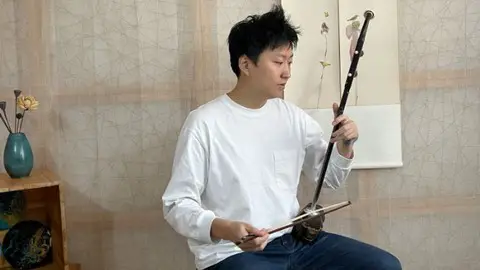Everyone Can Play Erhu– The Chinese Violin
Published 12/2023
MP4 | Video: h264, 1920x1080 | Audio: AAC, 44.1 KHz
Language: English | Size: 2.55 GB | Duration: 1h 57m
Published 12/2023
MP4 | Video: h264, 1920x1080 | Audio: AAC, 44.1 KHz
Language: English | Size: 2.55 GB | Duration: 1h 57m
The beginner course of Chinese traditional instrument Erhu
What you'll learn
be able to know what is Erhu and the history about Erhu
be able to read the sheet music for Chinese instruments (Movable Do system)
be able to play smooth and beautiful sound by using Erhu
be able to do proper fingering skill and play in tune
be able to play some repertoires by using Erhu
Requirements
You need to be able to sing the solfège if you want to learn this instrument
You need to own an Erhu
You need to practice the instrument frequently according to the guidance
Description
In this course, you will explore the structure of the Erhu with the teacher, learn the basic principles of sound production of the Erhu, learn how to read the Erhu notation, how to bow, how to press the strings, and how to produce beautiful tones with the Erhu. You will receive assignment in the lesson, and diligent practice will solid your playing skill. After completing this course, you will be able to play some beautiful pieces with the Erhu. In addition, you will be able to read the numbered notation and practice this instruments by yourself.Through learning this course, you will learn how does Erhu sound like, the basic structure of Erhu and how to choose your own Erhu.Further more, you will know how to assemble the Erhu and replace the strings, fine tuners, bows by yourself.Also you will learn how to tune the Erhu strings. Afterward, you will learn how to move the bow and produce beautiful sound by using erhu, and you will get tips to avoid the noise. From this chapter you need to follow the guidance and do some practice!You will know how to read Chinese numbered sheet music and follow the teacher to read the music and play the instrument in the later chapter. By this time, you should feel comfortable to move the bow and you will start to do fingering. In the eighth and ninth chapter, you will learn the D major scale in the first position. Lots of etudes and repertoires will be offered and you need to practice them. When you start to practice the etudes and repertoires, you can always practice from slow speed and gradually speed up. If you can't keep up, please tune the video speed to 0.5x or 0.75x.Please practice the instrument frequently and leave me a message if you meet problems.Through the practice, you will grab the basic skill of Erhu playing in D major first position and you will learn G major first position etudes and repertoires in later chapters.After you finish this course, you will be able to continue your Erhu learning by yourself, find some sheet music and play the songs you like.
Overview
Section 1: Introduction to the Erhu
Lecture 1 The brief history of Erhu
Lecture 2 The basic structure of the Erhu
Lecture 3 How to choose your own Erhu
Section 2: How to setup your Erhu
Lecture 4 How to install the strings
Lecture 5 Bows of Erhu and how to install the bows
Lecture 6 How to install the bridge
Lecture 7 Qianjin–One of the very important part of Erhu
Lecture 8 Fine tuners
Lecture 9 Rosin the bow
Lecture 10 How to pack up your Erhu and how to take it out
Section 3: Hold the bow and move the bow
Lecture 11 Sitting position
Lecture 12 How to hold and control the bow
Lecture 13 Pull and push the bow
Lecture 14 Move your arm and relax your wrist
Lecture 15 Right hand position of playing the inner string
Lecture 16 Right hand position of playing the outer string
Section 4: Tuning the Erhu
Lecture 17 Be careful when using the tuning peg
Lecture 18 The two strings of Erhu
Lecture 19 How to use the tuner
Lecture 20 How to use the fine tuners
Lecture 21 Demonstration of tuning D and A string
Section 5: Begin to play
Lecture 22 Get ready to play
Lecture 23 How to produce good sound by using the bow
Lecture 24 Open string practice -D string
Lecture 25 Open string practice -A string
Section 6: How to read the Chinese numbered sheet music
Lecture 26 What does the numbers represent
Lecture 27 Key signatures
Lecture 28 Beats and rhythm
Lecture 29 Demonstration of singing a sheet music
Lecture 30 Numbers of the fingers
Section 7: Open string etude
Lecture 31 Open string etude
Section 8: D major left hand fingering practice on first position
Lecture 32 First finger of left hand
Lecture 33 First finger etude
Lecture 34 Left hand second finger
Lecture 35 Second finger etude of 60 BPM and 90 BPM
Lecture 36 Put your third finger on the string and play the D major scale
Lecture 37 First, second and third finger etude of 60 BPM and 90 BPM
Lecture 38 Pentatonic etude for first, second and third finger
Lecture 39 Important!!! Fourth finger practice and it's three Etudes
Section 9: Some etude of difficult rhythm and bow switching
Lecture 40 Dotted crotchet etude
Lecture 41 Dotted quaver and legato
Lecture 42 When bow switching meets legato
Lecture 43 Dotted quaver and retaining finger
Lecture 44 Syncopation
Section 10: Repertoires of beginners in D major or b minor
Lecture 45 Repertoire 1: <鄂伦春小唱>(Oroqen solo singing)
Lecture 46 Repertoire 2: <凤阳花鼓>(Fengyang flower drum)
Lecture 47 Repertoire 3: <田园春色> (Pastoral spring)
Lecture 48 Repertoire 4: <玛依拉>( Maira)
Section 11: G major first position practice
Lecture 49 The G major scale
Lecture 50 Etude of G major scale1
Lecture 51 Etude of G major scale2
Lecture 52 Etude of 3rd and 4th fingers in G
Section 12: Repertoires for beginners in G major or e minor
Lecture 53 Repertoire 1:
Lecture 54 Repertoire 2:
Lecture 55 Repertoire 3:
Lecture 56 Repertoire 4:
Section 13: Conclusion for this beginner course
Lecture 57 How do we continue practice
For all music fans who wants to learn this special Chinese instrument,Music teachers who wants to learn an extra instrument



